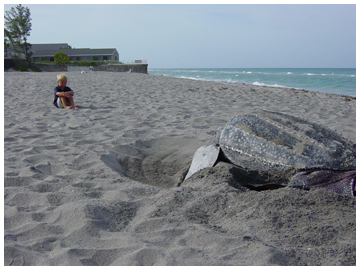
Sea turtle nesting in Northwest Florida begins May 1
Sea turtle nesting season has begun on some of Florida’s beaches and will begin in earnest all over the state in the coming weeks. On some southeastern Florida beaches, endangered leatherback sea turtles are already laying eggs. This is good news after a winter that saw thousands of cold-stressed sea turtles successfully rescued and returned to the sea by the Florida Fish and Wildlife Conservation Commission (FWC), with the assistance of many partner agencies and volunteers.
The start of nesting season means beach residents and visitors need to follow a few precautions to ensure a successful season.
People should manage lights along the beach to prevent disorienting the female who comes ashore at night, according to biologists with the FWC. To do this, shield lights needed for human safety so they are not visible from the beach, or turn them off when not in use. The instincts of the ancient sea creature tell her to proceed toward the brighter horizon over the ocean. Bright lights on the landward side of the beach can confuse the nesting sea turtle and the hatchlings that emerge from the nest. Lights on the beach can lead them away from the water.
“Just one light can kill thousands of turtles over several years,” said Dr. Robbin Trindell, a biologist with the FWC. “Many lights burn all night, without contributing to human safety. We ask that folks be conscious of those unnecessary lights.”
Five species of sea turtles nest on Florida beaches, with the loggerhead showing up in the largest numbers. Green and leatherback sea turtles also nest in the Sunshine State. While southern beaches typically host two or three hawksbill nests each year, nests of the highly endangered Kemp’s ridley have increased in recent years, with nests documented in the Panhandle and on southwest and southeast coast beaches.
The FWC lists the loggerhead as a threatened species; the other four are endangered.
Recently, the U.S. Fish and Wildlife Service announced it would recommend listing the loggerhead species that nests in Florida as endangered.
Nearly 90 percent of the loggerhead population that nests in the southeastern United States nests on Florida’s beaches. This population is one of only two large loggerhead nesting populations worldwide.
Sea turtles are air-breathing reptiles well-suited for sea life, with a hydrodynamically shaped shell and large, powerful front flippers. These physical characteristics enable them to dive deep into the ocean and to swim long distances.
Female loggerhead turtles begin coming onshore in the spring, with peak months for laying eggs in June and July. The nesting female digs a hole with her rear flippers and then lays approximately 115 eggs. After covering the nest with sand, the massive creature, weighing from 150 to 300 pounds, makes her way back to the ocean. A female might come ashore two to five times during the nesting season. Amazingly, the females come back to the same stretch of shoreline where they hatched decades earlier. The males, once they make the long crawl after hatching out of the egg, never return to land.
Late in the summer, after an incubation of 55-70 days, the hatchlings begin breaking out of their shells. Up to 100 hatchlings wait below the sand surface until darkness, when they emerge together and crawl out of the nest. Instinct tells the 1- to 2-inch hatchlings to head toward the brightest horizon and away from dark silhouettes. In days long gone in Florida, the brightest horizon shone over the ocean, and the hatchlings would move away from the shadows on the dunes and begin the crawl to the sea.
In modern-day Florida, hatchlings must crawl through a battlefield of debris left by humans. Furniture discarded by lazy beachgoers can obstruct a nesting female turtle or become a trap for the hatchlings. Avoiding fireworks leftovers strewn along the hatchling’s path can cause exhaustion and delay in getting to the water. If stranded on the beach when the sun rises, the hatchlings’ chance for survival diminishes and dehydration and sun exposure become hazards.
“We can all help sea turtles survive,” Trindell said. “If we just take personal responsibility, we can go a long way to ensure the sea turtle co-exists with us for many more years to come.”
For wildlife-friendly lighting options, go to MyFWC.com/Wildlife and click on “Living with Wildlife.”
The public can help efforts to conserve and fund research for sea turtles by purchasing a specialty license plate or decal. The extra fee for the sea turtle plate helps fund the Sea Turtle Grants Program. Approximately 30 percent goes to the grants program, which the nonprofit Caribbean Conservation Corporation administers. Visit www.helpingseaturtles.org for more information. The other 70 percent of tag revenue goes to the FWC’s Marine Turtle Protection Program to support research and management activities related to sea turtles.
For information about our local sea turtle volunteer group, go to: https://www.waltonoutdoors.com/dedicated-group-watches-over-sea-turtles/
